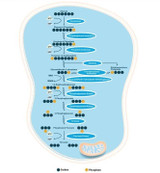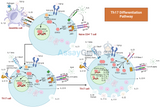Tips for Writing a Thesis Statement
Writing a Thesis Statement
Writing a thesis statement can be a frustrating task, whether you're working on your undergraduate, master's, or PhD degree. Unfortunately, many teachers and professors don't provide clear examples of what a good thesis statement looks like or what elements it should include. If you're struggling to write your thesis statement, this blog post offers some helpful tips to consider. Plus, we've included a worksheet to help you improve your skills. Whether you're just starting out or finishing up your thesis, these resources can help you craft a strong and effective thesis statement.
Thesis Statement Worksheet
Our "Thesis Statement Writing Worksheet" is full of of examples and exercises to help you refine your thesis statement writing skills!
Download Answers!
Tips for Writing a Thesis Statement
1.) Collect Your Thoughts
After writing so much for your thesis, collecting all your thoughts together and expressing them in about 500-700 words for your thesis statement can be difficult. When I was writing up my PhD thesis, the statement was the last section I put together and even though it was only 700 words it was one of the most corrected sections of my PhD thesis. The main reason for this that your thesis statement is where your examiner will get the first impression of what your thesis is about. Because writing your thesis statement can be somewhat stressful I thought I would give an example of sections that are involved:
2.) A Strong Opening Line in Your Thesis Statement
First impressions are important and this will definitely be the case with your statement. The first line of your statement should be give an overview of what the relevance of the research area is, here are some examples from scientific papers:
“During the effector CD8+T-cell response, transcriptional differentiation programs are engaged that promote effector T cells with varying memory potential” ( taken from Kurtulus S et al 2014).
“Mammalian forkhead-box family members belonging to ‘O’ category (FoxO) manipulate a plethora of genes modulating a wide array of cellular functions including cell cycle regulation, apoptosis, DNA damage repair and energy metabolism.” (taken from Shukla S et al 2014).
I know the science might be to specialized for a lot of you, but what these opening lines do is provide the reader an overview of why the area of research that they are about to discuss is relevant. In the examples above these opening lines prepare the reader for what is about to come and give them a reference point for why they have carried out this research and wrote this thesis.
3.) Historical Perspective in the Thesis
The next few lines in a thesis statement provide a historical overview of the area of research and discuss what previous results have shown. Some key phrases used in this sections are: “Previous research has shown” “It has been reported that” This section is the build up for what you are about to discuss and give an overview of. This section again highlights the importance of what you are about to discuss and argue. Mentioning key finding in these lines also give you leverage on what you are about to argue for or against.
4.) Our Data Has Shown
The next section of your thesis statement will give a the reader an overview of the data or findings of your thesis. Some common opening lines in this section are: “Here, we investigated” “Here we report” “Our data has shown that” In this section you will give an overview of key findings that show the power of your results.
An example might be: “Here we shown that eating an apple everyday reduces cholesterol levels, improves gut microflora and increases serotonin levels. Furthermore we demonstrate that eating a apple in the morning improves dietary choices for all subsequent meals and reduces anxiety.”
5.) Increase The Power of Your Research
To increase the power of your research finding you can discuss some of the instrumentation or methods that you use to collect your results. This might look like: “Using data from 300 questionnaires carried out by a random population we found that ….” Also combining your research methods might also help. Using publically available data and samples we collected from 100 patients and analysed using gene sequencing we found that….”
6.) Supporting Your Data
If possible, using supporting data is a nice way of carrying out a convincing argument in your thesis statement. Even though this data might have not given your primary outcome, this data might give other examples of why this research was important, relevant or supporting to your argument.
7.) Thesis Statement Conclusion
The concluding lines of your thesis statement will wrap all your thoughts into one nice package, discuss how your results where relevant to the field and gives you closing argument. Some key phrases in a conclusions might look like this: “Here we conclude that running five miles a day improves muscle mass, reduces weight when combined with a nutritional diet and increases lifespan.”
When writing your thesis statement, try to keep it within 500 – 800 words long, check for spelling errors and grammatical mistakes and always make sure that your facts are correct and not just taken from Wikipedia. If required you can always put references in your statement, however, some formats may not allow this depending on where you are submitting.
Related Resources
Written by Sean Mac Fhearraigh
Seán Mac Fhearraigh PhD is a co-founder of Assay Genie. Seán carried out his undergraduate degree in Genetics at Trinity College Dublin, followed by a PhD at University College Dublin. He carried out a post-doc at the Department of Genetics, University of Cambridge. Seán is now Chief Technical Officer at Assay Genie.
Recent Posts
-
Biological Role of GLP-1
Glucagon-like peptide-1 (GLP-1) is a critical hormone in the regulation of glucose met …20th Jun 2024 -
Th17 Cell Differentiation: Insights into Immunological Dynamics
Th17 cells, a subset of T helper cells characterized by their production of interleukin-17 (IL- …25th May 2024 -
Assay Genie New Asian Distributor May 2024
Dublin, Ireland — May 20th 2024 — Assay Genie, a leading supplier of ELISA Kits, Ant …19th May 2024




